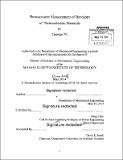Photoacoustic measurement of bandgaps of thermoelectric materials
Author(s)
Ni, George (George Wei)
DownloadFull printable version (6.389Mb)
Other Contributors
Massachusetts Institute of Technology. Department of Mechanical Engineering.
Advisor
Gang Chen.
Terms of use
Metadata
Show full item recordAbstract
Thermoelectric materials are a promising class of direct energy conversion materials, usually consisting of highly doped semiconductors. The key to maximizing their thermal to electrical energy conversion lies in optimizing three inter-related material properties, thermal conductivity, electrical conductivity, and Seebeck coefficient. All three properties are affected by the carrier concentration of the thermoelectric material. In practice, tedious trial-and-error testing is needed to determine the optimal carrier concentration for the maximum figure-of-merit, ZT. Theory and computer simulations of thermoelectric properties can aid the determination of new thermoelectric materials, but several challenges remain. The bandgap is a key piece of bandstructure information, but is difficult to determine for heavily doped thermoelectric materials. Under heavy doping conditions, the effective mass and bandgap both change due to the formation of Urbach band tails and other defect states within the bandgap. Furthermore, bandgaps of heavily doped materials are difficult to observe optically, due to significant amounts of carriers in defects states within the bandgap. Conventional optical measurement techniques relying on transmittance change require extremely thin samples, on the order of microns for thermoelectrics. Photoacoustic spectroscopy is used in this work to optically probe the thermoelectric bandgap, without the need to produce thin samples. Photoacoustic spectroscopy allows simultaneous measurements of the thermal conductivity and optical absorption coefficient. In this work, a relative measurement is devised to reduce the need to carefully control experimental parameters such as light input and microphone gain. Semiconductor theory is discussed to account for the band-filling effects, and a method is proposed to extrapolate the true electronic bandgap from the Burstein-Moss shift of the absorption edge due to heavily doping.
Description
Thesis: S.M., Massachusetts Institute of Technology, Department of Mechanical Engineering, 2014. Cataloged from PDF version of thesis. Includes bibliographical references (pages 78-81).
Date issued
2014Department
Massachusetts Institute of Technology. Department of Mechanical EngineeringPublisher
Massachusetts Institute of Technology
Keywords
Mechanical Engineering.